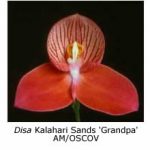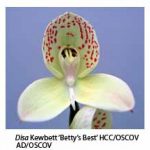Disa uniflora is a terrestrial orchid that grows naturally on Table Mountain near Cape Town, South Africa. It is usually found growing on the banks of streams, where its roots are rarely dry. The weather is cold and wet in winter and warm and dry in summer; much like our Melbourne weather so one can grow disas here with very little protection. They may be grown outdoors for most of the year, as long as they are provided with 50% shade in summer.
My latest growing medium is as follows:
one part of small river pebbles.
one part of sharp sand.
one part of coarse Perlite (always moisten Perlite before use to avoid breathing in any dust).
half a part of fine Cocopeat. Soak the Cocopeat before use and break it up by hand to form a loose, fibrous material. A weak solution of a liquid fertilizer may be used rather than water for soaking the Perlite and Cocopeat. The ingredients are then mixed thoroughly together by hand.
Disas are annual plants. The flowering plant will die down in autumn and several new plants should appear around the base of the old one. These may be separated and re-potted in April or May. Use pots that are just large enough to accommodate the roots. Plants respond well to re-potting and usually put on fresh growth. The pots may be placed in polystyrene foam boxes to moderate the root temperature. A sheet or two of newspaper placed in the bottom of the box will absorb water and provide a cool, moist atmosphere in summer. The main flowering period is in early to mid summer.
Good air movement and bright light should prevent any fungal diseases. Liquid fertilisers may be used as necessary and a little slow release fertilizer may also be used. Aphids and thrips may be controlled with simple insecticides

